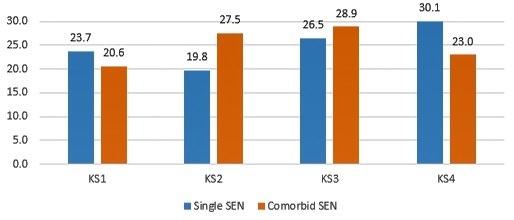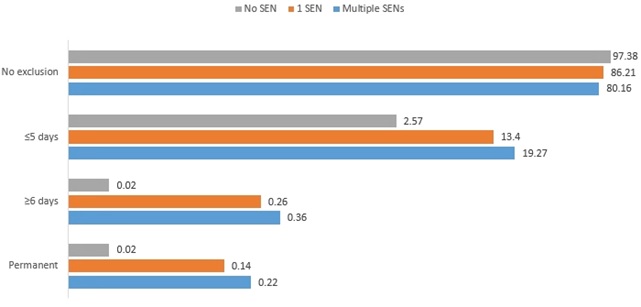Mae'r cynnwys hwn ar gael yn Saesneg yn unig.
The presence of special education needs (SEN) and variations in school-level provision can cause disruptions in a pupil’s educational journey, especially when that child’s needs change as they progress through key stages. This may especially be the case when pupils have multiple needs, including mental health and communication difficulties. Furthermore, gaps between the time of identification of a need and the delivery of specialised provision can lead to an increased number of school exclusions and an overall unstable school-level environment. These problems can have long-term consequences outside the school setting, such as juvenile offending, thus negatively affecting children across their lifespan.
Despite previously established links between SEN and school exclusion, further investigation is needed to determine how variation in the timing of identification of SEN might be subsequently linked to more complex needs arising. This could be attributed to the deterioration of the pupil’s educational achievement, and other indicators of disrupted learning, including exclusion. It is also important to explore whether an increasing level of need might lead to increasing (more lengthy or even permanent) exclusion.
This blog post is the next in a series undertaken for the “Excluded Lives” project, a multi-disciplinary collaboration across multiple UK universities. The series presents preliminary findings from analyses carried out in the WISERD Education Data Lab on education records of pupils in mainstream education in Wales, with a focus on the link between complex special education needs and experiences of school exclusion.
What did we do?
This post expands on the analyses presented in a previous post focusing on excluded pupils across Wales, drawing together information on different aspects of SEN and exclusion data. The analyses focused on the period between 2011/12 and 2016/17, for which data on types of SEN and school exclusion were available. We grouped separately those pupils with a single type of need identified and those with multiple needs to investigate how the number of SEN relates to the initial identification of need, and particularly how this might relate to the severity of exclusion experiences.
In terms of school exclusion data, pupils who experienced fixed term exclusions were grouped as “≤5 days lost” and “≥6 days lost” per academic year, while a separate category (“permanent”) was used for pupils with recorded permanent exclusion. This categorisation was used to explore how the link between the presence of SEN and type of school exclusion might differ by the presence of single or multiple identified needs.
What did we find?
Upon investigation of how identification of SEN at different key stages relates to the presence of multiple needs later on, it was observed that early detection linked to lower comorbidity (presence of one or more additional conditions) later in life. This was evident in relation to SEN identified in key stage 1 which were primarily grouped as having a single SEN (23.7% versus 20.6% for comorbid). This finding could be linked to the provision of more suitable support being tailored to each pupil when allocated at an earlier stage, improving the child’s outcomes and potentially reducing disruption in the education process which could be caused by the delayed identification of needs during key stage 2 or even later during key stage 3.
Figure 1. Timing of SEN identification and comorbid SEN

We further examined whether the presence of more than one identified need was linked to more frequent and severe experiences of school exclusion. As seen in Figure 2, a higher proportion of both longer fixed and permanent exclusions was observed among pupils who had multiple SEN types when compared to having a single need (0.36% versus 0.26%; 0.22% versus 0.14% respectively), with the lowest proportions seen in those with no identified SEN.
Figure 2. Severity of exclusion by number of SEN types identified

Overall, the analyses presented in this post suggest that early identification of a need is linked to a reduced presence of co-occurring needs later on, potentially minimising disruption in education. It was also highlighted by the higher proportion of longer fixed and permanent exclusions being recorded among pupils with multiple SEN types, suggesting that children with complex needs could be experiencing more disruptions in their education.
What do we plan to do next?
We are planning to investigate how characteristics of school exclusion instances, including reason for exclusion, is linked to the severity of an exclusion.
About the WISERD Education Data Lab:
WISERD Education Data Lab undertakes independent analysis of administrative education data, survey data and data linkage, alongside knowledge exchange and public dissemination of findings to inform national debate on some of the most contemporary and pressing educational issues facing Wales.
WISERD Education Data Lab has received support from Administrative Data Research Wales, alongside funding from Welsh Government, Economic and Social Research Council (award: ES/012435/1) and Cardiff University.
The statistics used in this report have been approved for publication by SAIL. This does not imply Welsh Government’s acceptance of the validity of the methods used to obtain these statistics, or of any analysis of the results. Rather, they have been deemed to be non-disclosive (i.e. individual pupils cannot be identified).


Photo by Mikhail Nilov from Pexels

